Not Just for Kids: Discovering the Magic of Picture Book Art
The Eric Carle Museum of Picture Book Art
If you’ve ever read The Hungry Caterpillar, you know who the author, Eric Carle is. But if you assume that his museum is for kids, you’d be wrong. The Eric Carle Museum of Picture Book Art is a dynamic, educational, fun-for-all museum.
How I Learned About the Eric Carle Museum
A few years ago, I took an online editing class. One of the participants emailed me afterwards and asked if I’d like to be editing buddies. Via FaceTime or Zoom, we’ve met nearly every week for over four years to chat, brainstorm, and share ideas about whatever writing project we’re working on. During one of our chats, she mentioned having been childhood best friends with Eric Carle’s wife, Barbara, known as Bobbie. She also mentioned that Eric and Bobbie had created a museum and how it had been inspired by the Carles’ travels to Japan where picture books are considered an art form. That conversation, along with many of her stories about both her childhood memories with Bobbie, and her lifelong friendship with Eric and Bobbie, prompted me to look up and start following the Eric Carle Museum on social media. It looked impressive! I did, however, need to educate myself about picture book art.
What is Picture Book Art?
Picture books, the ones we read to our kids, may seem too simple to be a form of art, but they are. Picture book art combines words and text in formats different to any other book form. Different to comic books. Different to books with illustrations. In picture books, the illustrations are integral to the story, sometimes even replacing parts of the narrative. The illustrations are not just decorative, they are critical to the story, as are the end-pages and the cover. The first museum of picture book art, the Chihiro Art Museum, opened in Tokyo in 1977. Two other examples of picture book art museums are the Museum of Picture Book Art in Taiwan, and The National Centre for Children’s Books in Newcastle, England.
My Visit Plan
Last summer, when planning my northeast museum road trip, I added the Eric Carle Museum to my list. I rented a car in Boston, the last big city on my trip after Philadelphia and New York, and drove towards western Massachusetts. The museum is in Amherst, a location selected by the Carles because they lived nearby, there are multiple colleges in the area, and it’s accessible across New England.
The Eric Carle Museum was the last of my 15 museum visits. I was so excited to be there that I arrived before they opened and waited impatiently for the door to open. I will say that as you drove into the parking lot you knew you’re in the right place because of the Hungry Caterpillar Volkswagen parked in front of the museum. (I understand the car has now moved on to a “new life.”)
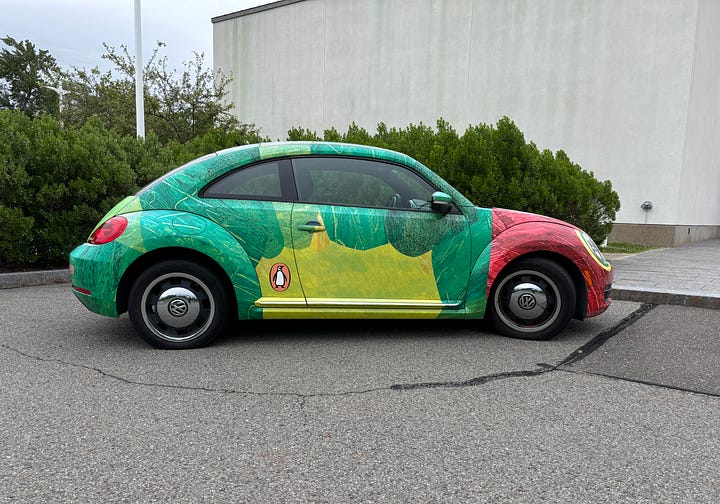

You walk in the door to openness, light, and floor-to-ceiling windows. Even though it was a grey, drippy day, it felt cheerful and welcoming. The whole time I was in the museum, I was smiling as I meandered into each colorful, well-designed, visitor-focused space.
Orientation: Yay!
Let me start with a congratulatory comment about their orientation timeline. Very few museums provide any type of orientation. Museums could create a timeline, a video, a collage of photos, or even a brief list of the museum’s highlights, but few do anything to orient their visitors. At the Carle, their timeline shares photos, quotes, and stories about Eric Carle’s life and art, information about his wife, Bobbie, and insights into the planning and construction of the museum. It’s colorful and easy to digest.
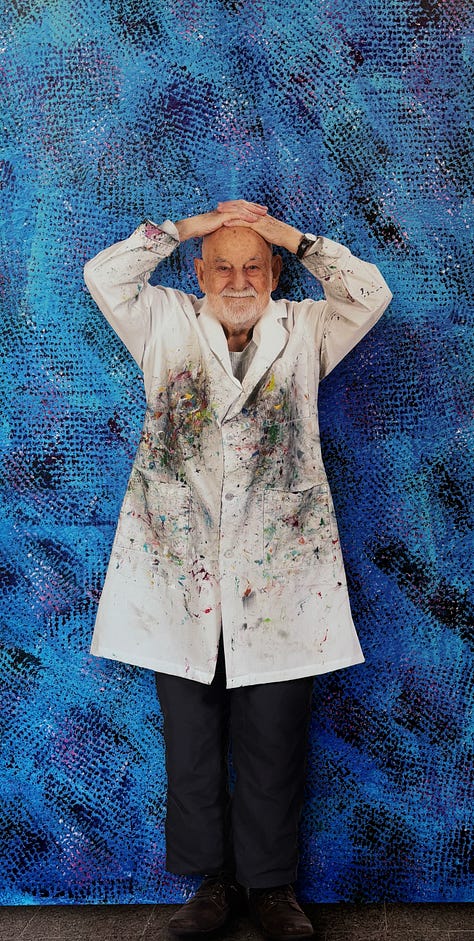
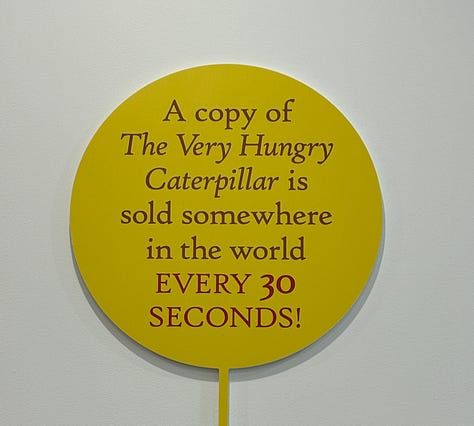
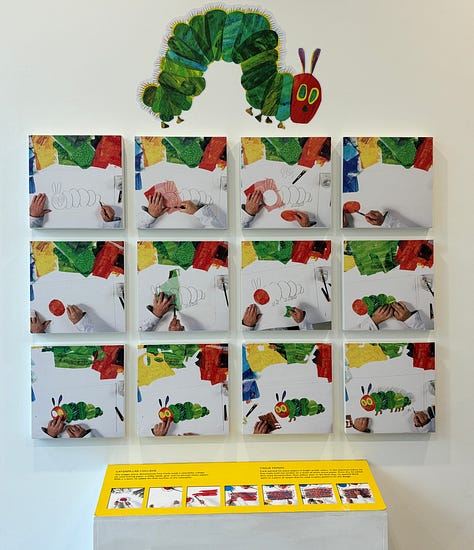
I was impressed with how intently invested the visitors were in their museum visit. I was pleased with the creatively displayed exhibits. I noticed the thoughtful interactivity fit into each exhibit. I loved the cozy library with its own tiny exhibit space. I stood in awe of the Great Hall with windows, art, and seating. I saw an Art Studio filled with the tools of creativity. The gift shop was replete with a multitude of products, all well-displayed. And the restroom! Wait until I tell you about the restroom!
The Art
“We wanted a place where art made for children could be understood as art. It’s a passion for us. We wanted to pass that passion on.” -Eric and Barbara Carle
Each of the three exhibit galleries had a different topic. They change out the exhibits a few times a year. One gallery is always Eric Carle’s work and the other two represent other picture book artists. I was especially taken with the exhibit called Bird Watching with Eric Carle. I loved the way they painted the walls. Over the last few years, some museums have slowly shifted from plain, single-color walls, but many don’t. This gallery had grass painted near the floor and clouds and sky painted near the ceiling. They showed Mr. Carle’s birds painted on the walls, and matted and framed. Some were his early sketches. Others were his finished version. And, to add to the bird watching theme, they created a bird lookout platform with plastic binoculars and images of birds to search for within the room.
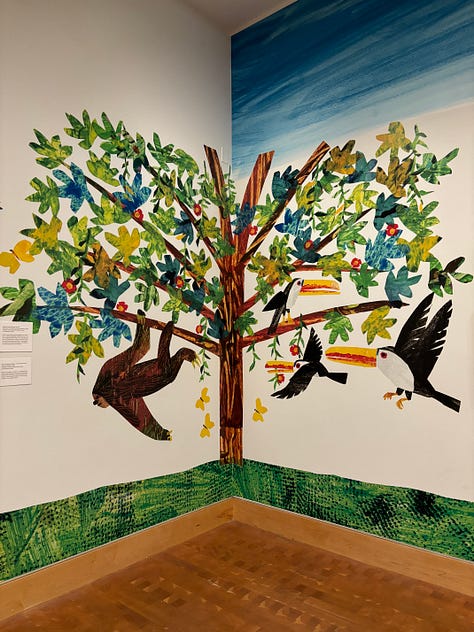

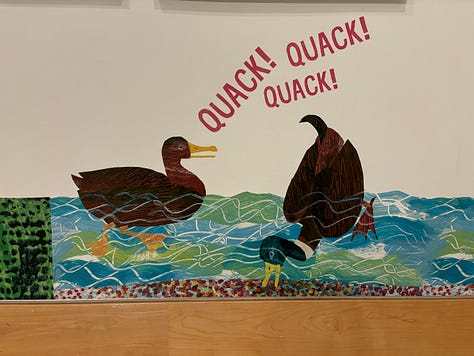
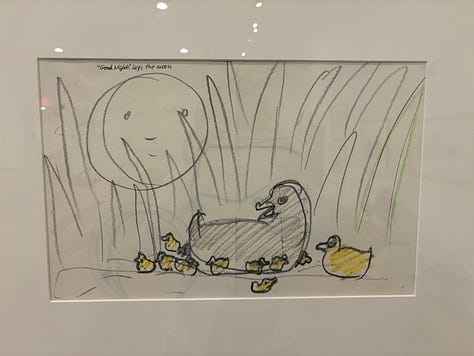


One of the other exhibits while I was there was titled, Fuzuê! Invention & Imagination in the Art of Roger Mello. Fuzuê is a Portuguese word meaning a playful commotion or a fuss. His art blends world folklore with Brazilian culture. The exhibit showcased Mr. Mello’s art in a fun, playful, creative way. Art on the walls. A “river” on the floor. Comfy chairs to sit in and explore his books. Playful activities for all!

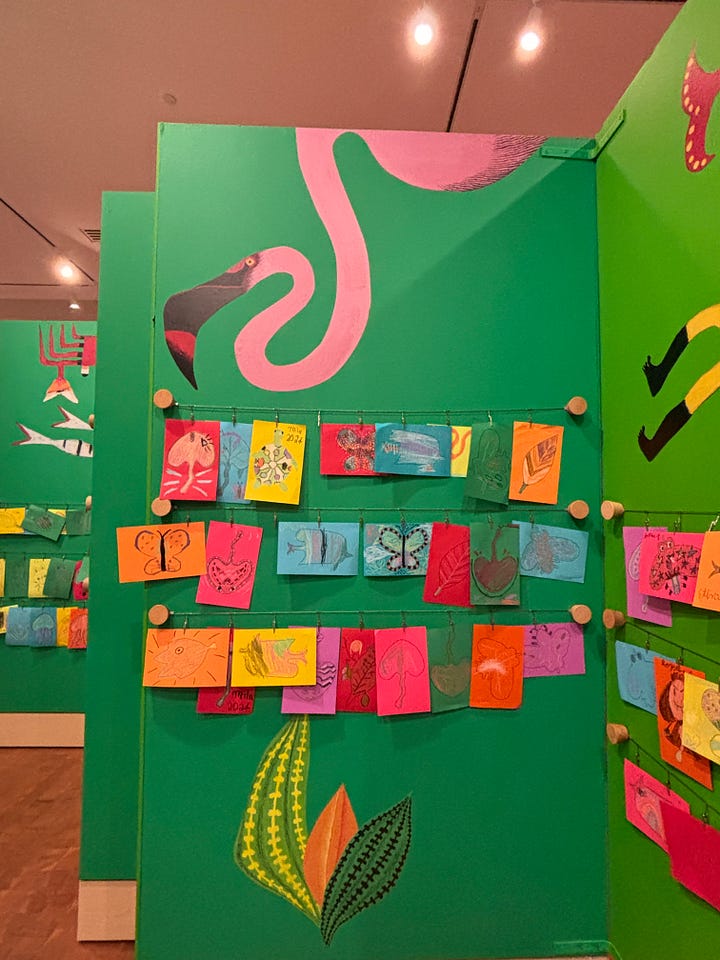
The third gallery was displaying Pictures at Play: Metafiction in Art, an exhibit about books that tell stories about stories. It included book art, books to read, and a magnetic bookshelf. It was delightful to explore, and it pushed me to stop and think about stories in a new way.
More Than the Art
Throughout the museum, visitors are provided with books to look through and various places to sit and enjoy the books or to contemplate the exhibits. It added a comfortable feel to the museum. Also, each gallery had fun, low-tech activities appropriate for children and adults. Writing. Drawing. Coloring. Matching. Doodling.
The Art Gallery has a wall of floor-to-ceiling windows that look out onto nature. The windows were at the direction of Eric Carle who had large windows in his own studio and wanted the museum’s studio to have a similar feel. There are work tables, art supplies, past art projects on display, useful sinks, and helpful staff. They change out projects every few weeks. It’s not meant to be a studio where you can come in and do whatever appeals to you, but rather a studio with intentional, planned activities related to one or more of the exhibits up at the time. Families were fully engaged as staff helped, supported, and encouraged everyone that came through the door.


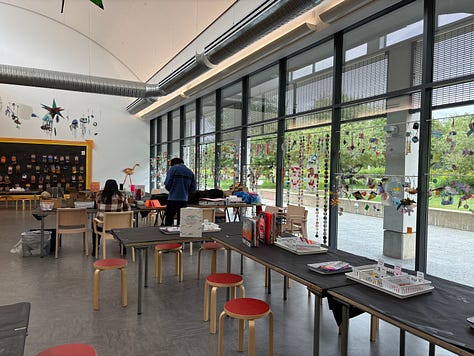
Step outdoors and you can wander through Bobbie’s Meadow, a place to honor Eric Carle’s wife and co-founder of the museum. The meadow is centered around a 100-year-old apple orchard, surrounded by native New England plants and flowers. It’s a restful compliment to the museum with accessible walkways and plenty of places to sit and admire.


The Reading Library has over 6,000 picture books and tables and chairs to sit and read. They include Eric Carle books, of course, along with award-winning picture books, books in foreign languages, and many old favorites.
No matter where I was in the museum, the staff was friendly and helpful. You had the feeling that they were delighted to share about the place that they worked at and loved!
Mission Statement
“The Eric Carle Museum of Picture Book Art is the international champion for picture book art. We collect, preserve, and exhibit original art; encourage guests of all ages to read and create art; and foster an ever-growing audience passionate about picture book art.”
Other Amenities
The museum doesn’t have a restaurant, but they do have indoor and outdoor eating spaces. The Carle Café has vending machines with healthy snacks and there’s an outdoor seating space appropriate for picnics.
The museum has a staff of about 50 and annual attendance of 300,000, which is significant, considering they aren’t in a big city. They are very accessible for all. They have assisted listening devices, color-blindness glasses, sensory bags, quiet areas, and weighted lap pads. Way to go, Eric Carle Museum!
As I was about to leave, I stopped in the restroom. The walls are covered with tile, highlighting many of Eric Carle’s animals. It made the space colorful and fun! And one of the toilets was child-sized. Thoughtful and appropriate!


I walked out, still smiling, delighted that I had found an art museum, albeit a niche topic of art, that was fun, educational, and creative in its displays.
More…




Thank you for your visit and kind words! We're so glad you enjoyed, please come back soon and let us know when you do! 💚
So fun! I smiled throughout my reading. :)